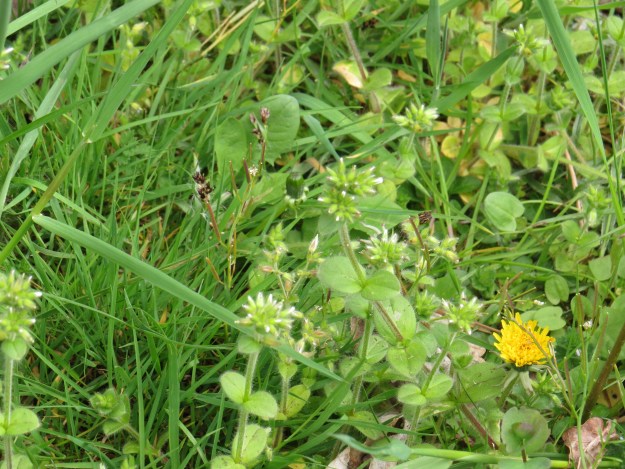
Sticky Mouse-ear (Cerastium glomeratum)
Dear Readers, some plants are so small, so unobtrusive and so ubiquitous as to go completely unnoticed. Sticky Mouse-ear, also known as ‘Clammy Chickweed’, is a member of the Carophyllaceae, which includes stitchworts, campions and pinks. It is extremely hairy, which gives it that ‘sticky’ feel, and has a starburst of tiny white flowers. The Latin genus name ‘Cerastium’ comes from the Greek word for ‘a horn’, and refers to the seed capsules. ‘Glomeratum‘ means ‘collected together’ (think of agglomerate). And so, the whole name means ‘horns collected together’. Not a bad description of the flowers, either. And as far as the ‘mouse-ear’ bit goes, the leaves are certainly small and furry.

Sticky Mouse-ear flowers (Photo One)
The plant was probably initially native to Eurasia, but has since spread to pretty much the whole world. It’s an annual that would have been harvested with grain or entangled in sheepskin, but it rarely occurs in such quantities as to be a pest. It is also a plant that likes it damp and shady (a typical woodland plant in other words), and it looks as if those delicate leaves could be shrivelled up very easily. No doubt one of my gardening/allotment friends will tell us that it has the tenacity of a hungry anaconda :-).

You might think that the plant would be way too small to be a valuable food, and you’d be (largely ) right, although it was eaten as a famine food in China (B.E. Reid’s Famine Foods of the Chiu-Huang Pen-ts’ao via Sticky Mouse-ear Chickweed, CERASTIUM GLOMERATUM (backyardnature.net)). Ordinary chickweed has been eaten as a salad vegetable in many cultures, but I imagine that the hairs probably put most people off. However, several caterpillars like the plant: the larvae of the small yellow underwing (Panemeria tenebrae) eats the ripening seeds of sticky mouse-ear, firstly by hiding inside the seed capsule, and then later by laying along the stem, where it is very well camouflaged.

Small yellow underwing moth (Panemeria tenebrata) (Photo Two)
It’s also one of the foodplants of the Coast Dart moth (Euxoa cursoria), a most unusual moth that is believed to spend all day hiding underground (usually in sandy coastal soils), emerging at night to feed. Several species of mouse-ear are coastal specialists, so I imagine that the caterpillars usually eat these, but ‘our’ plant may well be taken if these aren’t available. The moth is also thought to be an immigrant, landing on our coasts every year. It’s an easily overlooked species, but is currently classified as ‘nationally scarce’.

Coast Dart (Photo Three)
Medicinally, the whole of the plant has been used as a diuretic, to encourage milk flow in nursing mothers, and as a general tonic. N. P Mandanhar’s book on Plants and People of Nepal describes how the juice from sticky mouse-ear was dropped onto the forehead as a treatment for a headache, and into the nostrils to staunch a nosebleed.

And now, here’s something interesting. The folk singer Bella Hardy was Musician in Residence in Yunnan, China, and combined several of the classic poems of the Shijing (written from 11 to 7BCE) with Chinese and Western instruments, to create something that is still distinctively Chinese but is cross-pollinated with traditional Western folk styles. Also, Bella has the most beautiful voice. This song is called ‘Gathering the Mouse-Ear’. Well worth a listen.
Photo Credits
Photo One by CC BY-SA 3.0, https://commons.wikimedia.org/w/index.php?curid=98387
Photo Two by Ilya Usyantsev from https://www.flickr.com/photos/155939562@N05/27206255498
Photo Three by Garry Barlow, from https://www.norfolkmoths.co.uk/index.php?bf=20830
Sticky Mouse-Ear: a fascinating name indeed – very descriptive too. I enjoy your Wednesday Weed posts very much – as I have enjoyed the introduction to the voice of Bella Hardy.
I assumed it was called a mouse-ear because of the double loop or notch at the end of the petals – what my book describes as ’emarginate’. It also says that ‘we’ have 10 species in the Alps (which are difficult to distinguish between – so no wonder I often get these things wrong!) But it does give details of 4 – the Rigid (Cerastium strictum), Starwort (C. cerastoides), Broad-leaved (C. latifolium) and One-flowered (C. uniflorum) – the first two being ‘rather common’ while the latter two are ‘not common’. They should be flowering in June to August and I’ll no doubt post a picture when I see one. (I know where there will be loads).
Common chickweed’s nice to eat, a bit like young spinach, but needs a lot of washing and picking over as it grows low and meets animal pee. What a treat to hear Bella Hardy, previously unknown to me.
Speedwells next – I dare you 😉